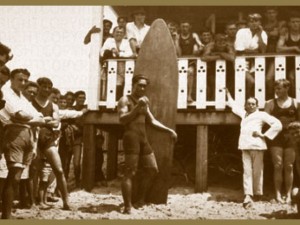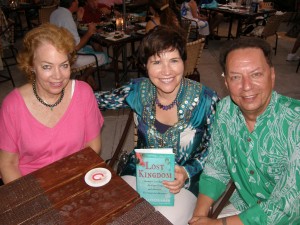Talking Story at the Outrigger Canoe Club
On my last night in Honolulu on tour for my new book, Lost Kingdom, I was invited for drinks at the Outrigger Canoe Club, which sits at the far end of Waikiki Beach, in the shadow of Diamond Head. The club is a key setting for the novel, The Descendants, which is now an Oscar-winning film starring George Clooney.
The Outrigger is a small, private club with an outsized history in Hawaii. Founded in 1908, it is the place where legendary surfer Duke Paoa Kahanamoku, a five-time Olympics medalist who competed as a swimmer and water polo player for the U.S. in the 1912, 1920, 1924, and 1932 games. A photo of Duke is mounted on the wood-paneled wall as you enter the dining room, with the words underneath it, “Ambassador of Aloha.”
Our host for drinks that evening was Puchi Romig, the outgoing chairman of the Friends of Iolani Palace, the group that supports the National Historic Monument through fund-raising and other activities. The highlight of her tenure may well have been last fall’s Renaissance Ball – the first formal ball at the palace in more than a decade.
One of the guests that joined us that evening at the Outrigger was Marvin “Puakea” Nogelmeier from the University of Hawaii’s Manoa campus, who is one of the world’s leading experts on the Hawaiian language. I’d had the opportunity to profile Puakea in a front-page story in the Wall Street Journal and had come to like and admire him very much. He has volunteered as a docent at the Palace since the mid-1980s.
Puakea, who had just returned from a trip to New Zealand, had brought with him a copy of his new book, Mai Pa’a I Ka Leo, which is about translating Hawaiian-language newspapers from the nineteenth century into English. He’s now deeply involved in a project to do just that – with some 2,500 volunteers pulling together to unlock this potentially huge treasure chest of information, which offers a much deeper look into the Hawaiian perspective from the times than we have today. Even non-Hawaiian speakers can help out: for more information, please visit the Awaiaulu project’s website.
Puakea had helped me better understand some of the subtleties of the Hawaiian language and had read and commented on the Note on Language that is at the end of Lost Kingdom. He has spent decades studying Hawaiian culture, language and history and, as a relative newcomer, I was grateful for his help, though I recognize that Lost Kingdom, as a popular history, could have benefited from using even more of the new Hawaiian language materials that he and other scholars are uncovering every day.
Puchi’s other guest was another true descendant, in her own way similar to Princess Abigail Kawananakoa, with whom I’d had lunch when I first arrived. She was Robin Midkiff, a Punahou and Stanford graduate who was a descendant of one of the most prominent missionary families. She is related to Juliette and Amos Starr Cooke, a missionary couple who taught Liliuokalani and other royal students at the Chief’s Children’s School in the 1830s and 1840s in Honolulu.
Robin is also related to Paul Neumann, an attorney who began his career in California but moved to Honolulu in the early 1880s, quickly rising to the position of the kingdom’s attorney general under King David Kalakaua. Neumann represented the last queen, Liliuokalani, at her military trial in 1895 and witnessed her forced abdication. To honor him, the deposed Queen and her lady-in-waiting had stitched his name into the Victorian era crazy quilt that they worked on together during Liliu’s eight months of house arrest at the palace.
In addition to working as a senior executive at the First Hawaiian Bank and serving as a member of the Atherton Family Foundation, Robin is deeply involved in preserving the history of Hawaii in her role as chairman of the Washington Place Foundation, the group formed to support the gracious, white pillared home in downtown Honolulu where Liliu spent most of her life. The deposed queen died at Washington Place in 1917 and it long served as the official residence for Hawaii’s Governor. In 2007, it was designated as a National Historic Landmark.
We watched for a green flash as the sun sank into the Pacific. Puakea and Robin talked history about the early days of Kamehameha I and his bloody conquest of the island of Oahu. As I sat between them listening to their conversation, I thought to myself how I’d never known a place where history lies so close to the surface of daily life – with reminders every day in the street names reflecting the days when the islands were ruled by Hawaiian royalty.


Aloha no, e Julia,
That was a delightful chance to chat, and a great group to be in, with you, Puchi, Robin and Lance Rae for a sunset synergism. The link to our project, http://www.awaiaulu.org didn’t connect from the blog, so if can, get that fixed so we can encourage willing hands to join in – you’re invited as well. Me ke aloha ia ‘oe,
Puakea
Thanks, Puakea. The link is now fixed and the name of the project added…would love to help out with the project when things settle down a bit.
Aloha,
Julie